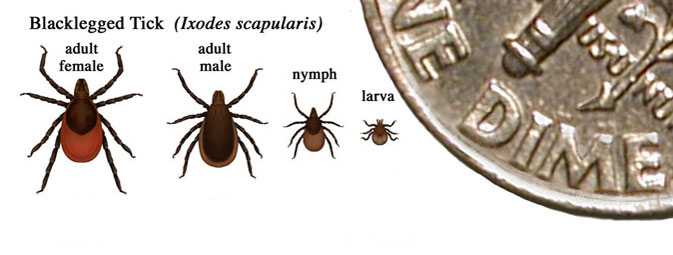Transmission
The Lyme disease bacterium, Borrelia burgdorferi, is spread through the bite of infected ticks. The blacklegged tick (or deer tick, Ixodes scapularis) spreads the disease in the northeastern, mid-Atlantic, and north-central United States. The western blacklegged tick (Ixodes pacificus) spreads the disease on the Pacific Coast.
Ticks can attach to any part of the human body but are often found in hard-to-see areas such as the groin, armpits, and scalp. In most cases, the tick must be attached for 36 to 48 hours or more before the Lyme disease bacterium can be transmitted.
Most humans are infected through the bites of immature ticks called nymphs. Nymphs are tiny (less than 2 mm) and difficult to see; they feed during the spring and summer months. Adult ticks can also transmit Lyme disease bacteria, but they are much larger and are more likely to be discovered and removed before they have had time to transmit the bacteria. Adult Ixodes ticks are most active during the cooler months of the year.
Relative sizes of blacklegged ticks at different life stages

In general, adult ticks are approximately the size of a sesame seed and nymphal ticks are approximately the size of a poppy seed.
Are there other ways to get Lyme disease?
- There is no evidence that Lyme disease is transmitted from person-to-person. For example, a person cannot get infected from touching, kissing, or having sex with a person who has Lyme disease.
- Lyme disease acquired during pregnancy may lead to infection of the placenta and possible stillbirth; however, no negative effects on the fetus have been found when the mother receives appropriate antibiotic treatment. There are no reports of Lyme disease transmission from breast milk.
- Although no cases of Lyme disease have been linked to blood transfusion, scientists have found that the Lyme disease bacteria can live in blood that is stored for donation. Individuals being treated for Lyme disease with an antibiotic should not donate blood. Individuals who have completed antibiotic treatment for Lyme disease may be considered as potential blood donors. Information on the current criteria for blood donation is available on the Red Cross website.
- Although dogs and cats can get Lyme disease, there is no evidence that they spread the disease directly to their owners. However, pets can bring infected ticks into your home or yard. Consider protecting your pet, and possibly yourself, through the use of tick control products for animals.
- You will not get Lyme disease from eating venison or squirrel meat, but in keeping with general food safety principles, always cook meat thoroughly. Note that hunting and dressing deer or squirrels may bring you into close contact with infected ticks.
- There is no credible evidence that Lyme disease can be transmitted through air, food, water, or from the bites of mosquitoes, flies, fleas, or lice.
- Ticks not known to transmit Lyme disease include Lone star ticks (Amblyomma americanum), the American dog tick (Dermacentor variabilis), the Rocky Mountain wood tick (Dermacentor andersoni), and the brown dog tick (Rhipicephalus sanguineus).
How ticks find their hosts
Ticks can't fly or jump. Instead, they wait for a host, resting on the tips of grasses and shrubs in a position known as "questing". While questing, ticks hold onto leaves and grass by their lower legs. They hold their upper pair of legs outstretched, waiting to climb onto a passing host. When a host brushes the spot where a tick is waiting, it quickly climbs aboard. It then finds a suitable place to bite its host.
How ticks attach to their hosts
The tick feeding process makes ticks very good at transmitting infection:
- Depending on the tick species and its stage of life, preparing to feed can take from 10 minutes to 2 hours. When the tick finds a feeding spot, it grasps the skin and cuts into the surface. The tick then inserts its feeding tube. Many species also secrete a cement-like substance that keeps them firmly attached during the meal. The feeding tube can have barbs, which help keep the tick in place.
- Ticks also can secrete small amounts of saliva with anesthetic properties so that the animal or person can't feel that the tick has attached itself. If the tick is in a sheltered spot, it can go unnoticed.
- A blacklegged tick will attach to its host and suck the blood slowly for several days. If the host animal has certain bloodborne infections, such as the bacteria that cause Lyme disease, the tick may ingest the pathogen and become infected. If the tick later feeds on a human, that human can become infected.
- After feeding, the blacklegged tick drops off and prepares for the next life stage. At its next feeding, it can then transmit the infection to the new host. Once infected, a tick can transmit infection throughout its life.
- If you remove a tick quickly (within 24 hours), you can greatly reduce your chances of getting Lyme disease. It takes some time for the Lyme disease-causing bacteria to move from the tick to the host. The longer the tick is attached, the greater the risk of acquiring disease from it.
Lifecycle of blacklegged ticks
The lifecycle of blacklegged ticks (Ixodes scapularis and Ixodes pacificus) generally lasts two years. During this time, they go through four life stages: egg, six-legged larva, eight-legged nymph, and adult. After the eggs hatch, the ticks must have a blood meal at every stage to survive.
Blacklegged ticks can feed from mammals, birds, reptiles, and amphibians. The ticks need to have a new host at each stage of their life, as shown below:

This diagram shows the lifecycle of blacklegged ticks that can transmit Lyme disease.
- Page last reviewed: March 4, 2015
- Page last updated: March 4, 2015
- Content source:


 ShareCompartir
ShareCompartir